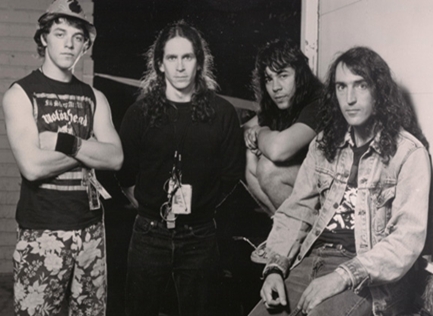With the new lineup in place, DRI spent the rest of 1990 and '91 playing sporadic shows and writing material for their sixth full-length. They hit the studio in June 1992, taking two months to lay down Definition with a new producer, Jim Faraci. A video was released for the song "Acid Rain," which would later be used in an episode of the MTV animated show Beavis and Butthead, but the album failed to chart, and critics were beginning to proclaim the band's career over. DRI's live reputation was still intact, and the band were offered the chance to play with numerous bands. Brecht and Cassidy eventually decided to jump on with Testament, who released their highest charting album to that point, The Ritual, in May. DRI's set at the Hollywood Palladium in November of '92 was filmed, and would be used for their first live album, Live. The album would be released in mid-1995 as a precursor to album number 7. John Menor left before the Testament tour ended, after the Palladium show, and was replaced by longtime band roadie and bass tech Chumly Porter.
With porter filling the bass slot, DRI hit the studio in late 1994 to begin working on its seventh full-length album. Unlike their Metal Blade releases and Definition, the band decided to produce the effort without an outside producer, Cassidy being listed as producer on the effort, released on November 14, 1995. Titled Full Speed Ahead, the album failed to generate much excitement, and sales were even worse than they had been for Definition. A video was released for the song "Syringes in the Sandbox," but was not played much on MTV and also failed to catch on with fans. The band announced the album would be their last, effectively ending their recording career, but assured the loyal fans of their live shows that touring would continue. The band did record a new song entitled "Against Me" in 2003, releasing it on their official website, but has yet to release another album or EP of new material since Full Speed Ahead. True to their word, however, the band has played live almost constantly, though they did take nearly two years off when Cassidy was diagnosed with colon cancer in 2006. The band continues to sell out large venues around the world and, despite the age and the wear and tear on those Dirty Rotten imbeciles, they still prove on a nightly basis they are the world's fastest band!
In addition to touring with D.R.I., Kurt Brecht also formed a band called Pasadena Napalm Division in 2010 with Dead Horse's Scott Sevall, Greg Martin and Ronny Guyote. The band released a self-titled EP in 2011 and a self-titled LP in 2013. Spike Cassidy has produced several albums on the Dirty Rotten label, including Acid Bath's 1994 album When te Kite String Pops and a 1997 effort entitled Token Remedies Research by Damaged.
|
|



